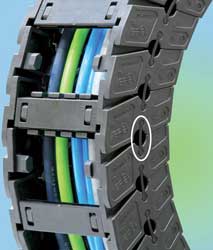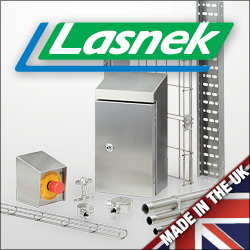
Posted to News on 28th Jan 2009, 22:14
E6 energy chain resists vibration better than alternatives
Energy chains are used in production equipment, robots and machine tools to guide and protect cables and hoses. Sometimes vibration can occur on the support channel and at the towing arm during the movement. The laboratory for tooling machines (WZL) and business operations RWTH Aachen carried out a study, Vibration investigations on energy chains, which concluded that the Igus E6 energy chain performed better than alternatives due to minimum vibration and maximum smooth running.

The WZL tested five energy chains on a highly dynamic linear test stand with direct drive. The E6 energy chain and the 380 series from the E4.100 standard programme, both from Igus, were investigated, as well as three comparable energy chains from other suppliers. The energy chains all had interior widths from 100-105mm and interior heights from 42-52mm. The speed of movement and acceleration of the system were varied (speeds of movement: 25, 50, 100 and 200m/min; accelerations: 10 and 20m/s2). The vibration near the energy chains was measured at 6000Hz using three-axis accelerometers on the towing arm and in the support channel.
Tests established that the towing arm required up to 28 per cent less energy with the E6 energy chain than with the other energy chains. The RWTH Aachen found the E6 to have the lowest vibration level by far. In line with this proof of smooth running, an official report prepared by the TUV Rhineland shows that the E6 is also extremely quiet. During laboratory tests in the company's technical centre, the energy chain was tested at 37dB(A) self-supporting at 1m/s.
Springs, not pivots
The key design feature of the Igus E6 energy chain is that the classical pin/bore connection has been replaced by a resilient polymer spring (highlighted in the photograph). The 'polygon effect' that can occur when an energy chain is unrolled is now reduced to a minimum. This leads to extremely low noise and almost vibration-free running of the energy chain. This is especially useful in combination with linear motors, for example, where extremely high accelerations can be achieved with the E6 while maintaining smooth motion. The resilient spring element of the E6 energy chain was successfully tested in the Igus laboratory for 220million cycles.
Thanks to its modular design, the E6 energy chain can be lengthened and shortened at any point. The spring element connects individual side parts into a sturdy energy chain that works fault-free during highly dynamic applications even after millions of cycles. The polymer spring elements are almost abrasion-free, as proven in tests by the IPA Fraunhofer Institute. With its abrasion-resistance and low wear, the E6 energy chain is suitable for clean room applications according to the specifications of the IPA Fraunhofer Institute (NB ISO Class 1 materials are required). Further typical areas of application are laser/torch cutting systems, measuring/test machines, semiconductor and electronics industry, medicine and pharmaceutical industry, machine tools, factory automation and high-speed handling.
Finally, the E6 energy chain is also available as an ESD (electro-static discharge) version for use in explosion-protection areas as well as for ESD interference resistance in sensitive production areas. The E6-ESD chain is made of the special Igus material GC, which has been certified by the Federal Physico-Technical Institute (PTB). Here, the spring element plays a central role. Thanks to this, the individual links in the energy chain are connected mechanically and electrically throughout all the installation positions. This way, E6-ESD achieves permanently constant conductive values without contact area wear.
Follow the link for more information about the Igus E6 energy chain.


















